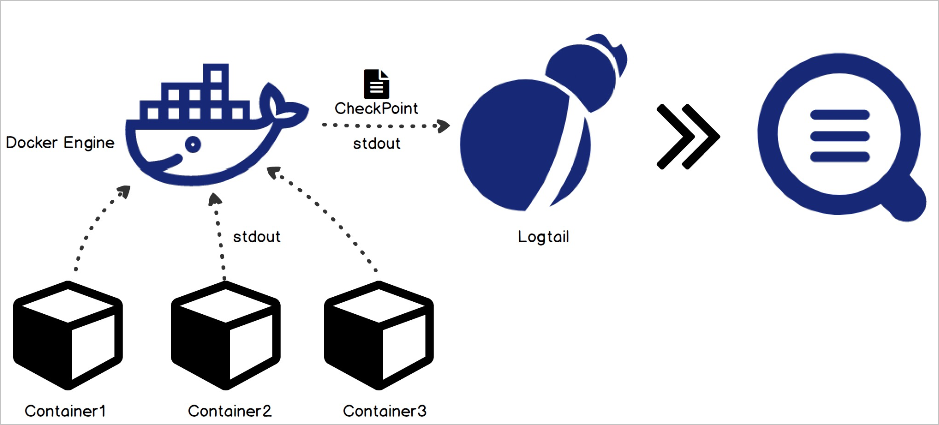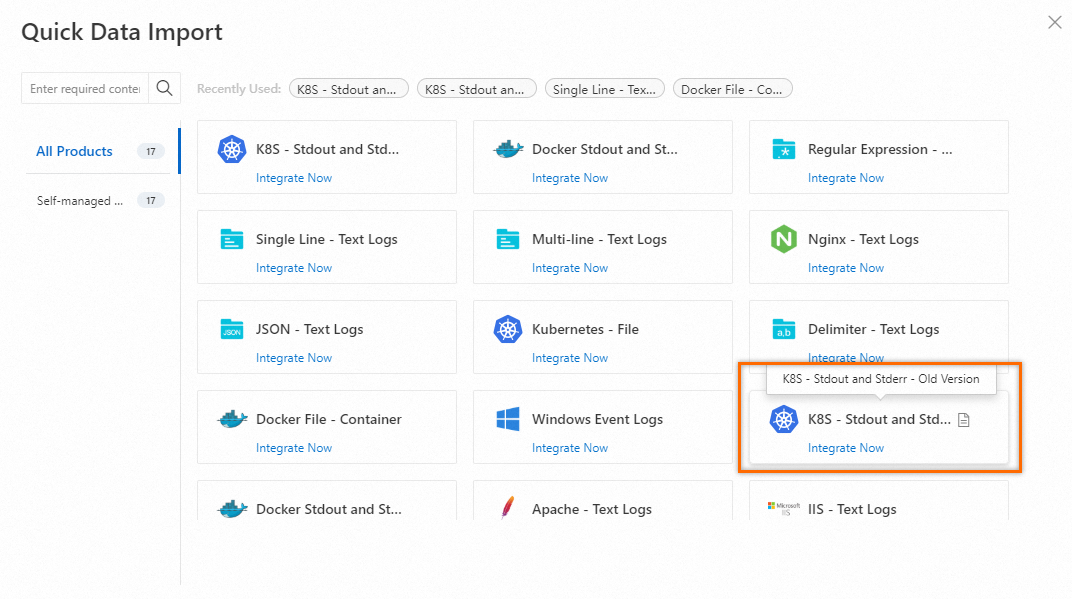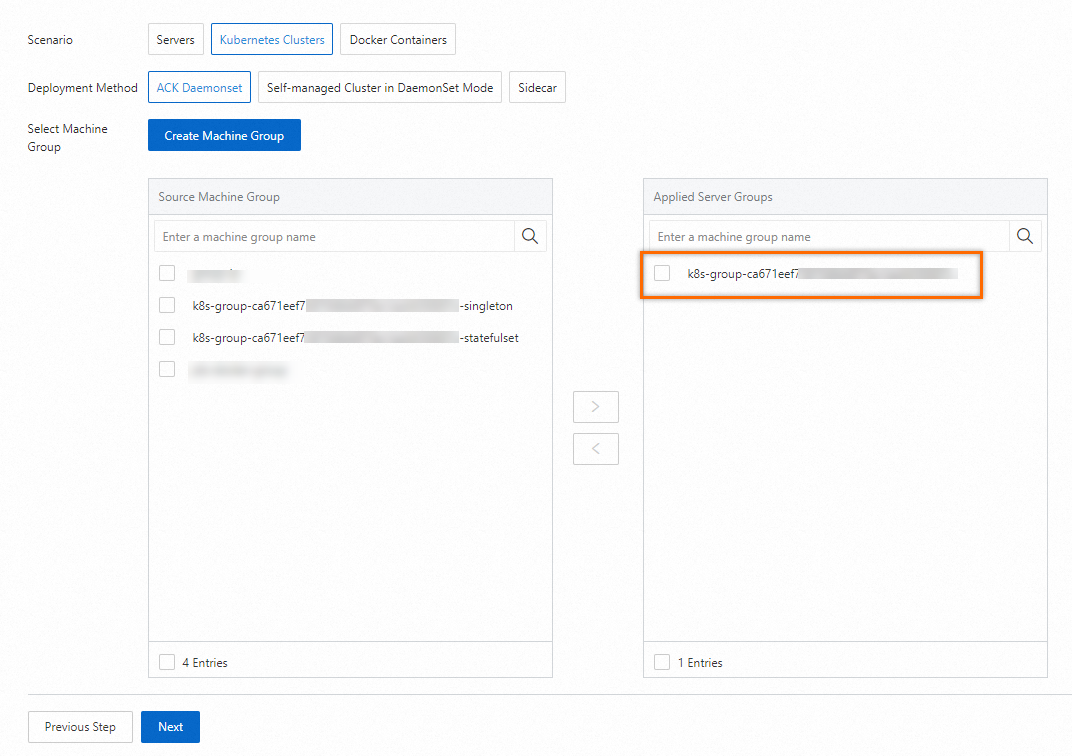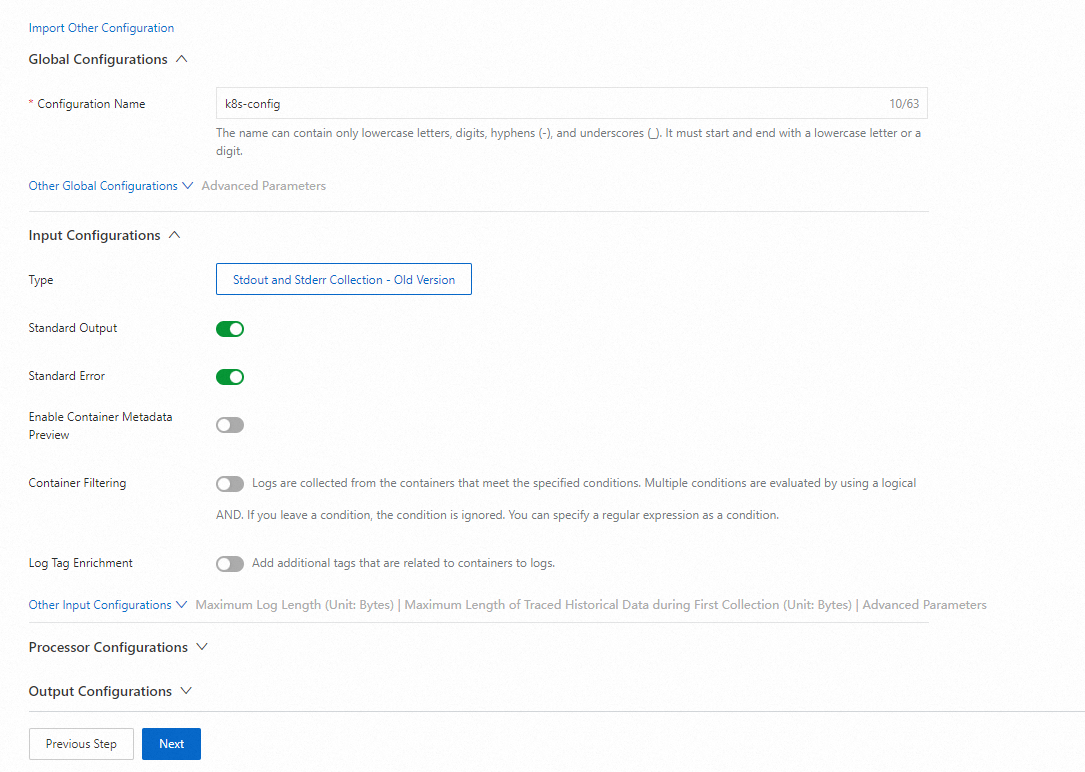This topic describes how to create a Logtail configuration in the Simple Log Service (SLS) console and use the Logtail configuration to collect stdout and stderr from containers in DaemonSet mode (old version).
Prerequisites
The Logtail component is installed. For more information, see Install Logtail components in a Kubernetes cluster.
A Logstore is created in the project that you use to install the Logtail component. For more information, see Create a Logstore.
The container from which you want to collect logs continuously generates logs.
ImportantLogtail collects only incremental logs. If a log file on a server is not updated after the applied Logtail configuration is delivered to the server, Logtail does not collect logs from the file. For more information, see Read log files.
Features
Logtail can collect the stdout and stderr generated from a container and upload the collected stdout and stderr together with the metadata of the container to SLS. Logtail provides the following features:
Collects stdout and stderr.
Uses the container label whitelist to specify containers from which logs are collected.
Uses the container label blacklist to specify containers from which logs are not collected.
Uses the environment variable whitelist to specify containers from which logs are collected.
Uses the environment variable blacklist to specify containers from which logs are not collected.
Collects multi-line logs. For example, Logtail can collect Java stack logs.
Automatically associates container metadata that needs to be uploaded together with the collected container logs. The metadata includes container names, image names, pod names, namespaces, and environment variables.
If a container runs in a Kubernetes cluster, Logtail also supports the following features:
Uses Kubernetes namespaces, pod names, and container names to specify containers from which logs are collected.
Uses the Kubernetes label whitelist to specify containers from which logs are collected.
Uses the Kubernetes label blacklist to specify containers from which logs are not collected.
Automatically associates Kubernetes labels that need to be uploaded together with the collected container logs.
Implementation
Logtail communicates with the domain socket of Docker. Logtail queries all Docker containers and identifies the containers from which stdout and stderr must be collected by using the specified labels and environment variables. Logtail determines the location of the log file in which the collected stdout and stderr are stored based on the container metadata for data collection.
When Logtail collects stdout and stderr from a container, Logtail periodically stores checkpoints to a checkpoint file. If Logtail is stopped and then started, Logtail collects logs from the last stored checkpoint.
Limits
You can collect stdout and stderr from Kubernetes containers in DaemonSet mode only if Logtail is of V0.16.0 or later and runs on Linux. For more information about how to view and upgrade the version of Logtail, see Install Logtail on a Linux server.
Logtail can collect data only from the containers that use the Docker engine or containerd engine.
Docker: Logtail accesses the Docker engine in the /run/docker.sock directory. Make sure that the directory exists and Logtail has the permissions to access the directory.
containerd: Logtail accesses the containerd engine in the /run/containerd/containerd.sock directory. Make sure that the directory exists and Logtail has the permissions to access the directory.
By default, the last multi-line log that is collected by Logtail is cached for 3 seconds. This prevents the multi-line log from being split into multiple logs due to output latency. You can modify the
BeginLineTimeoutMsparameter to change the cache time. We recommend that you do not specify a value that is less than 1000 with millisecond precision. If you specify a value that is less than 1000, an error may occur.If Logtail detects the
dieevent on a stopped container, Logtail no longer collects stdout or stderr from the container. If collection latency exists, some stdout and stderr that are collected before the container is stopped may be lost.If a container uses the Docker engine, the logging driver can collect stdout and stderr only in the JSON format.
By default, stdout and stderr that are collected from different containers by using the same Logtail configuration have the same context. In this case, you cannot view the context of stdout and stderr in the SLS console by using the contextual query feature or LiveTail feature. If you want to view the context in the preceding scenario, you must add aggregator configurations. For more information, see Overview of Logtail plug-ins for data processing.
By default, the collected data is stored in the
contentfield. Logtail can process the collected data. For more information, see Overview of Logtail plug-ins for data processing.
Create a Logtail configuration
Form configuration
Log on to the Simple Log Service console. In the Projects section, click the project that you want to manage.
On the tab, click the logstore that you want to manage.
Click the rightwards arrow to the left of the Logstore name and choose Data Collection > Logtail Configurations. On the Logtail Configuration page, click Add Logtail Configuration.

In the Quick Data Import dialog box, click Kubernetes - Stdout and Stderr - Old Version.

In the Machine Group Configuration step, add the machine group that is automatically created by the Logtail component to the Applied Server Groups section and select it. The name of the machine group is
k8s-group-*. Click Next.
In the Logtail Configuration step, configure the parameters described in the following tables.

Configure the parameters in the subsequent steps as prompted to create the Logtail configuration.
(Recommended) CRD - AliyunPipelineConfig
Only the Logtail component V0.5.1 or later supports AliyunPipelineConfig.
To create a Logtail configuration, you need to only create a custom resource(CR) by using the AliyunPipelineConfig custom resource definition (CRD). After you create the Logtail configuration, the system automatically applies the Logtail configuration.
Obtain the kubeconfig file of a cluster and use kubectl to connect to the cluster.
Run the following command to create a YAML file.
In the following command,
cube.yamlis a sample file name. You can specify a different file name based on your business requirements.vim cube.yamlEnter the following script in the YAML file and specify the parameters based on your business requirements.
ImportantYou must configure a CR for each Logtail configuration. If multiple CRs are associated with the same Logtail configuration, the CRs other than the first CR do not take effect.
For more information about the parameters related to the
AliyunPipelineConfigCRD, see (Recommended) Use AliyunPipelineConfig to manage a Logtail configuration. In this example, the Logtail configuration includes the basic settings used to collect container stdout and stderr. For more information about the parameters, see CreateLogtailPipelineConfig.Make sure that the
Logstorespecified by theconfig.flushers.Logstoreparameter exists. You can specify thespec.logstoreparameter to automatically create a Logstore.
Collect stdout and stderr from specific containers in multi-line mode
In this example, a Logtail configuration named
k8s-stdout-is created to collect stdout and stderr from the containers whose names containappin multi-line mode. The collected logs are stored in a Logstore namedk8s-stdout, which belongs to a project namedk8s-log-clusterid.apiVersion: telemetry.alibabacloud.com/v1alpha1 # Create a CR by using the ClusterAliyunPipelineConfig CRD. kind: ClusterAliyunPipelineConfig metadata: # Specify the name of the resource. The name must be unique within the Kubernetes cluster. The name is the same as that of the created Logtail configuration. name: example-k8s-stdout spec: # Specify the project to which logs are collected. project: name: k8s-log-clusterid # Create a Logstore to store logs. logstores: - name: k8s-stdout # Configure the parameters for the Logtail configuration. config: # Optional. Specify the sample log. sample: | 2024-06-19 16:35:00 INFO test log line-1 line-2 end # Configure the input plug-in. inputs: # Use the service_docker_stdout plug-in to collect stdout and stderr from containers. - Type: service_docker_stdout Stdout: true Stderr: true # Configure conditions to filter containers. Multiple conditions are evaluated by using a logical AND. # Specify the namespace of the pod to which the required containers belong. Regular expression matching is supported. K8sNamespaceRegex: "^(default)$" # Specify the name of the required containers. Regular expression matching is supported. K8sContainerRegex: "^(.*app.*)$" # Configure settings for multi-line log collection. # Specify the regular expression that is used to match the beginning of the first line of a log. BeginLineRegex: \d+-\d+-\d+.* # Configure the output plug-in. flushers: # Use the flusher_sls plug-in to deliver logs to a specific Logstore. - Type: flusher_sls Logstore: k8s-stdout Endpoint: cn-hangzhou.log.aliyuncs.com Region: cn-hangzhou TelemetryType: logsRun the following command to apply the Logtail configuration. After you apply the Logtail configuration, Logtail starts to collect stdout and stderr from containers and sends the collected stdout and stderr to SLS.
In the following command,
cube.yamlis a sample file name. You can specify a different file name based on your business requirements.kubectl apply -f cube.yamlImportantAfter logs are collected, you must create indexes before you can query and analyze the logs in the Logstore. For more information, see Create indexes.
CRD-AliyunLogConfig
To create a Logtail configuration, you need to only create a CR by using the AliyunLogConfig CRD. After the Logtail configuration is created, the system automatically applies the Logtail configuration.
Obtain the kubeconfig file of a cluster and use kubectl to connect to the cluster.
Run the following command to create a YAML file. In the following command,
cube.yamlis a sample file name. You can specify a different file name based on your business requirements.vim cube.yamlEnter the following script in the YAML file and specify the parameters based on your business requirements.
ImportantThe value of the
configNameparameter must be unique in the SLS project in which the Logtail component is installed.If multiple CRs are associated with the same Logtail configuration, the Logtail configuration is affected when you delete or modify one of the CRs. After a CR is deleted or modified, the status of the other associated CRs becomes inconsistent with the status of the Logtail configuration in SLS.
For more information about CR parameters, see Use AliyunLogConfig to manage a Logtail configuration. In this example, the Logtail configuration includes the basic settings used to collect container stdout and stderr. For more information about the parameters, see CreateConfig.
Collect container stdout and stderr in single-line mode
In this example, a Logtail configuration named
example-stdout-exampleis created to collect stdout and stderr from the containers whose names start with app in a Kubernetes cluster in single-line mode. The collected logs are stored in a Logstore namedk8s-stdout, which belongs to a project namedk8s-log-clusterid.# The configurations for container stdout and stderr collection. apiVersion: log.alibabacloud.com/v1alpha1 kind: AliyunLogConfig metadata: # Specify the name of the resource. The name must be unique within the Kubernetes cluster. name: simple-stdout-example spec: # Specify the name of the Logstore. If the specified Logstore does not exist, SLS automatically creates a Logstore. logstore: k8s-stdout # The Logtail configuration. logtailConfig: # Specify the type of the data source. If you want to collect stdout and stderr, set the value to plugin. inputType: plugin # Specify the name of the Logtail configuration. The name must be the same as the resource name that is specified in metadata.name. configName: simple-stdout-example inputDetail: plugin: inputs: - # input type type: service_docker_stdout detail: # Specify that Logtail is used to collect both stdout and stderr. Stdout: true Stderr: true K8sPodRegex: "^(app.*)$"Run the following command to apply the Logtail configuration. After you apply the Logtail configuration, Logtail starts to collect stdout and stderr from containers and sends the collected stdout and stderr to SLS.
In the following command,
cube.yamlis a sample file name. You can specify a different file name based on your business requirements.kubectl apply -f cube.yamlImportantAfter logs are collected, you must create indexes before you can query and analyze the logs in the Logstore. For more information, see Create indexes.
Preview container metadata
After you create a Logtail configuration, you can view container metadata and the reason why specific containers failed to match the filter conditions on the Logtail Configuration page.
Only Logtail V1.4.0 and later that run on Linux or Logtail V1.4.0.0 and later that run on Windows support this feature.
In the Projects section, find the project that is used to create the Logtail configuration and click its name.
In the left-side navigation pane, click Log Storage. In the Logstores section, find the Logstore that is used to create the Logtail configuration, click the rightwards arrow> to the left of the Logstore name, and then choose .
On the Logtail Configuration page, find the Logtail configuration that you created and click its name.
On the Logtail Configuration page, click Edit.
Turn on Enable Container Metadata Preview.
Click Container Metadata Preview.
In the Container Preview dialog box, view container metadata.
The Matched Containers tab displays the metadata of the containers that match the specified filter conditions.
The All Containers tab displays the metadata of all containers in the current Kubernetes cluster and the reason why specific containers failed to match the filter conditions.
Log fields
The following table describes the fields that are uploaded by default for each log in a Kubernetes cluster.
Field | Description |
_time_ | The time when the log was collected. |
_source_ | The type of the log source. Valid values: stdout and stderr. |
_image_name_ | The name of the image. |
_container_name_ | The name of the container. |
_pod_name_ | The name of the pod. |
_namespace_ | The namespace of the pod. |
_pod_uid_ | The unique identifier of the pod. |
Troubleshooting
If an exception occurs when you use Logtail to collect logs from containers, such as standard containers and Kubernetes containers, you can troubleshoot the issue based on the following references:
If the stderr logs cannot be parsed because the format of stderr logs is different from that of access logs, we recommend that you add indexes to the log content to facilitate querying for error-related log records. SLS does not allow you to use plug-ins to extract fields and parse logs based on the extracted fields. For more information, see Create indexes.